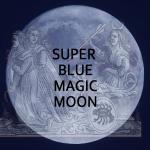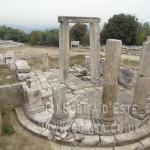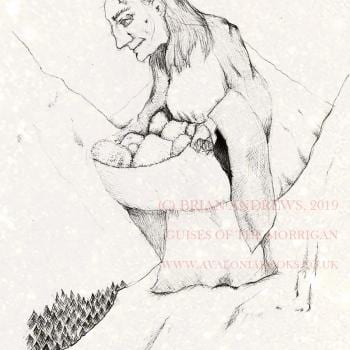Is the goddess Hekate a Goddess of Light? Or Dark?
“And the son of Cronos made her a nurse of the young
who after that day saw with their eyes the light of all-seeing Dawn.”
Theogony, Hesiod, circa 750 BCE.
Although Hekate is frequently described in contemporary Pagan texts as a “Dark Goddess” literature and iconography has linked her, for nearly 3000 years, with light. Curiously however, claiming that Hekate is a Goddess of Light can sometimes awaken an almost irrational reaction from individuals who describe her as a Dark Mother, Goddess of the Underworld, Queen of Hell or even as a Goddess of Darkness. However, her most iconic images, even today, depict her with two torches aloft, illuminating the darkness!

Hekate’s torches are the light in the darkness, it reveals that which is hidden and it shines as a beacon for initiates seeking pathways towards an understanding of the Mysteries. Her torches provide protection from the unseen forces, and her torches are also weapons. Her torches have been equated to the planet Venus, the first and last light of the day – and of the night. It is also understood to represent the light of the stars or the Moon, both of which she is associated with. The flames she carries also constitute the element of fire; completing her four-fold elemental nature, when linked to the three worlds she rules over a portion of the Ocean (water), Earth (Earth) and Starry Heavens (air).
“Hekate leads the way with her torches aloft in her capacity as the preceder and follower of Persephone on her yearly journey from the realm of the living on Earth above to the world of the dead, below. From the world of her mother the Grain Goddess Demeter to that of her husband, Hades. These journeys were part of the public mysteries celebrated at Eleusis, which Clement of Alexandria wrote about…” ~ Circle for Hekate, Vol. I- History & Mythology, d’Este (2017)
She is shown with torches in the secretive role she has at the Eleusinian Mysteries (Greece), where it is speculated torches were used to lead candidates for initiation on a symbolic journey. Here too she had a role in guiding Persephone on her yearly journeys to and from Hades, a journey which marked the beginning and end of the productive growing season. Torches would have illuminated the way, but may also have served a symbolic role representing some form of enlightenment. Likewise, torches are linked to Hekate’s role as a protectress and as a warrior – and as a goddess protecting travellers at crossroads and on roads. She uses her torches to fight in the Titanomachy, the war in which the Olympian Gods led by Zeus, fought against the chaotic Titans and won.
Legends of famous theurgists passed down through literature records that when prayers and incense were offered to her, the torches of her statue magically burst forth in flame. A notable example of this can be found involving the future Julian the Apostate (Emperor of Rome who tried to return Rome to Paganism) in Ephesus. Modern devotees likewise report fascinating phenomena with candle flames and fire during ceremonies honouring Hekate today.
Historical records also claim several instances where the Goddess used light to protect and safeguard the devoted. Mysterious light manifested over the water in ancient Byzantium (modern Istanbul, Turkey) after they invoked Phosphoros, this allowed the Byzantines to defend themselves against an invasion from the Macedonians. The Goddess similarly manifested as a pillar of light guiding a devotee from captivity to safety.
“… Come to me, horned-faced, light-bringer,
Bull-shaped, horse-faced goddess…”
~ PGM IV:2547-2550, Betz, 1997.
Hekate, like Artemis, had a long and established association with the New Moon – the first sliver at the beginning of the Lunar Month. Later, when the goddess Selene becomes first equated to Hekate, and then subsumed into her cult, Hekate gained a powerful and lasting association with the brightest luminary of the night sky: the Moon.

Lamps (see examples depicted above & below, from the British Museum Collection, London), decorated or shaped with images of Hekate, is a reminder that Hekate’s light illuminates the dark.

Why then is Hekate a “Dark Goddess” and is it correct to refer to her as such?
Hekate’s association with the night – through her mother the Star Goddess Asteria; her association with the Moon and with Caves and the very idea that she illuminates with the light she bears is suggestive of Hekate as dwelling in the very darkness which she illuminates. She (or the light she carries) is the light in the dark. If darkness is the absence of light, and light the lack of darkness, then Hekate is both a Goddess of Light and a Goddess of the Dark. But there is another palpable angle to this.
Hekate is able to use her torches to fight against the Titans because fire can burn. It is the fear of being burned which makes fire such an excellent tool for protection, combined with the way in which the light it produces reveals that which is hidden. Today we continue to use light to make a place safe – streetlights, security lights, torches and car headlights all contribute towards our safety (or feeling of security) on a daily basis. It stops us from tripping up or bumping into that which we are unable to see in the dark. Light can also reveal or highlight many beautiful things, and we talk about “shining light” on knowledge which was previously hidden being revealed. But coming face to face with that which was previously hidden can be a harrowing experience, and it can be both frightening and unwelcome. The truth about a situation is not always desirable, and it can be terrifying, especially in cases where it has been hidden in plain sight for a long time. This is the kind of light which Plato wrote about in The Cave. In this way, the revelation of what was hidden, with its potential for transformation, may at the same time become a genuinely terrifying experience. Hekate’s light has the potential to be both illuminating and transformative; and dreadfully dark and petrifying.
Further reading: Circle for Hekate, Vol.I – History and Mythology by Sorita d’Este.
This Equinox week the CoH community celebrates the Goddess of the Crossroads with our #hekatelight project, exploring different associations Hekate has with light. www.hekatecovenant.com
















